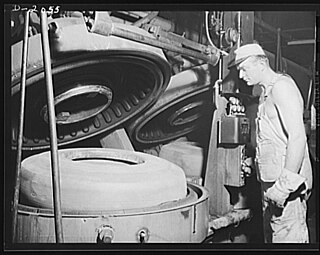
Vulcanization is a range of processes for hardening rubbers. The term originally referred exclusively to the treatment of natural rubber with sulfur, which remains the most common practice. It has also grown to include the hardening of other (synthetic) rubbers via various means. Examples include silicone rubber via room temperature vulcanizing and chloroprene rubber (neoprene) using metal oxides.
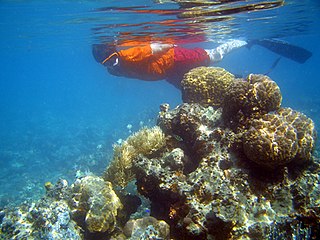
Snorkeling is the practice of swimming on or through a body of water while equipped with a diving mask, a shaped breathing tube called a snorkel, and usually swimfins. In cooler waters, a wetsuit may also be worn. Use of this equipment allows the snorkeler to observe underwater attractions for extended periods with relatively little effort and to breathe while face-down at the surface.

Rubber fetishism, or latex fetishism, is the fetishistic attraction to people wearing latex clothing or, in certain cases, to the garments themselves. PVC fetishism is closely related to rubber fetishism, with the former referring to shiny clothes made of the synthetic plastic polyvinyl chloride (PVC) and the latter referring to clothes made of rubber, which is generally thicker, less shiny, and more matte than latex. PVC is sometimes confused with the similarly shiny patent leather, which is also a fetish material. Latex or rubber fetishists sometimes refer to themselves as "rubberists". Gay male rubberists tend to call themselves "rubbermen".

Prosthetic makeup is the process of using prosthetic sculpting, molding and casting techniques to create advanced cosmetic effects. Prosthetic makeup goes back to the beginning of film making with A Trip to the Moon, a 1902 French adventure short film directed by Georges Méliès where the man on the moon effect was accomplished using a combination of makeup and a prosthetic type mask with added pastes. The makeup artist Jack Pierce was another early Hollywood make-up artist, best remembered for creating the iconic makeup worn by Boris Karloff in Frankenstein, his makeup for the Wolfman, and more. Modern prosthetic makeup was revolutionized by John Chambers, whose work can be seen in Planet of the Apes, as well as Dick Smith's work in Little Big Man, Stan Winston in the Terminator series, and Rob Bottin in The Thing.

A dry suit or drysuit provides the wearer with environmental protection by way of thermal insulation and exclusion of water, and is worn by divers, boaters, water sports enthusiasts, and others who work or play in or near cold or contaminated water. A dry suit normally protects the whole body except the head, hands, and possibly the feet. In hazmat configurations, however, all of these are covered as well.
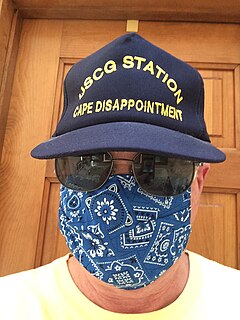
A disguise can be anything which conceals or changes a person's physical appearance, including a wig, glasses, makeup, fake moustache, costume or other items. Camouflage is a type of disguise for people, animals and objects. Hats, glasses, changes in hair style or wigs, plastic surgery, and make-up are also used.

A bondage hood is a fetishistic hood. It may be made from rubber, latex, PVC, spandex, darlexx or leather. Full-faced hoods are typically used for the practice of head bondage, and to restrain and objectify the wearer through depersonalization, disorientation and/or sensory deprivation.

A laryngeal mask airway (LMA), also known as laryngeal mask, is a medical device that keeps a patient's airway open during anaesthesia or while they are unconscious. It is a type of supraglottic airway device. They are most commonly used by anaesthetists to channel oxygen or inhalational anaesthetic to the lungs during surgery and in the pre-hospital setting for unconscious patients.
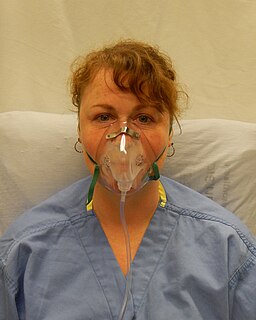
An oxygen mask provides a method to transfer breathing oxygen gas from a storage tank to the lungs. Oxygen masks may cover only the nose and mouth or the entire face. They may be made of plastic, silicone, or rubber. In certain circumstances, oxygen may be delivered via a nasal cannula instead of a mask.

A swimming cap, swim cap or bathing cap, is a tightly fitted, skin-tight garment, commonly made from silicone, latex or lycra, worn on the head by recreational and competitive swimmers.
A facial prosthetic or facial prosthesis is an artificial device used to change or adapt the outward appearance of a person's face or head.

Jack Pierce was a Hollywood make-up artist best remembered for creating the iconic makeup worn by Boris Karloff in Frankenstein (1931), along with various other classic monster make-ups for Universal Studios.
A synthetic rubber is any artificial elastomer. They are polymers synthesized from petroleum byproducts. About 32-million metric tons of rubbers are produced annually in the United States, and of that amount two thirds are synthetic. Global revenues generated with synthetic rubbers are likely to rise to approximately US$56 billion in 2020. Synthetic rubber, just like natural rubber, has many uses in the automotive industry for tires, door and window profiles, seals such as O-rings and gaskets, hoses, belts, matting, and flooring. They offer a different range of physical and chemical properties, so can improve the reliability of a given product or application. Synthetic rubbers are superior to natural rubbers in two major respects, thermal stability and resistance to oils and related compounds. They are more resistant to oxidizing agents, such as oxygen and ozone which can reduce the life of products like tires.

Latex rubber is used in many types of clothing. Rubber has traditionally been used in protective clothing, including gas masks and Wellington boots. Rubber is now generally being replaced in these application by plastics. Mackintoshes have traditionally been made from rubberized cloth.

Foundation is a liquid, cream, or powder makeup applied to the face and neck to create an even, uniform color to the complexion, cover flaws and, sometimes, to change the natural skin tone. Some foundations also function as a moisturizer, sunscreen, astringent or base layer for more complex cosmetics. Foundation applied to the body is generally referred to as "body painting" or "body makeup".

Latex is an emulsion of polymer microparticles in water. Latexes are found in nature, but synthetic latexes are common as well.
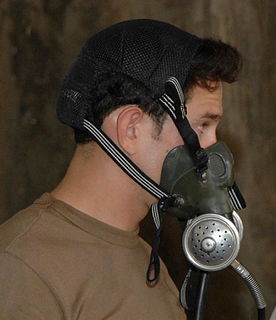
An orinasal mask, oro-nasal mask or oral-nasal mask is a breathing mask that covers the mouth and the nose only. It may be a complete independent item, as an oxygen mask, or on some anaesthetic apparatuses, or it may be fitted as a component inside a fullface mask on underwater breathing apparatus, a gas mask or an industrial respirator to reduce the amount of dead space. It may be designed for its lower edge to seal on the front of the lower jaw or to go under the chin.
RTV silicone is a type of silicone rubber that cures at room temperature. It is available as a one-component product, or mixed from two-components. Manufacturers provide it in a range of hardnesses from very soft to medium—usually from 15 to 40 Shore A. RTV silicones can be cured with a catalyst consisting of either platinum or a tin compound such as dibutyltin dilaurate. Applications include low-temperature over-molding, making molds for reproducing, and lens applications for some optically clear grades. It is also used widely in the automotive industry as an adhesive/sealant, for example to create gaskets in-place.

The horse head mask is a latex mask representing a horse head originally manufactured by novelty purveyor Archie McPhee, and now widely available from other manufacturers. It covers the entire head and is typically part of a Halloween costume, or is worn at other times to be funny, shocking, incongruous, or hip, or to disguise one's identity. It has also become an internet meme.




















